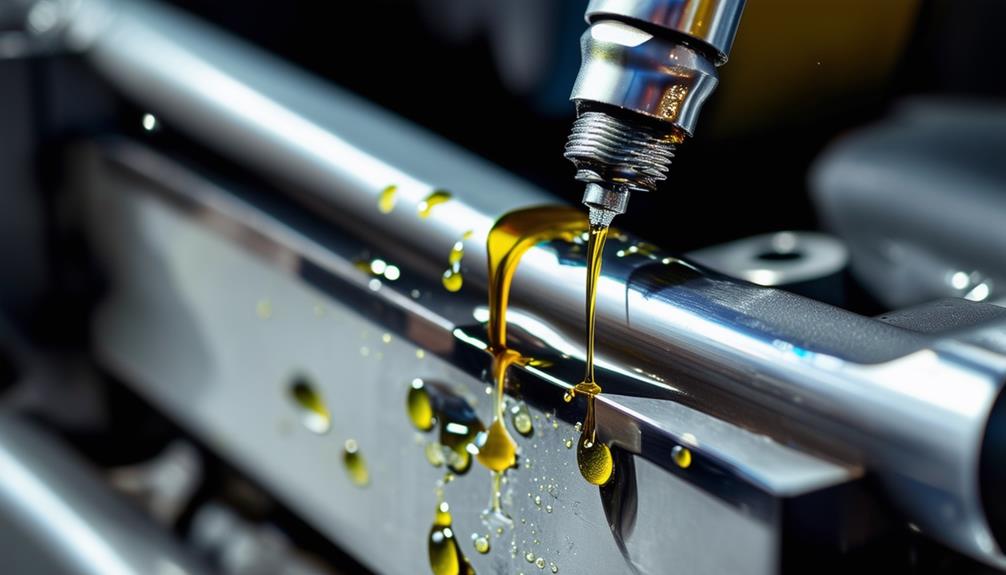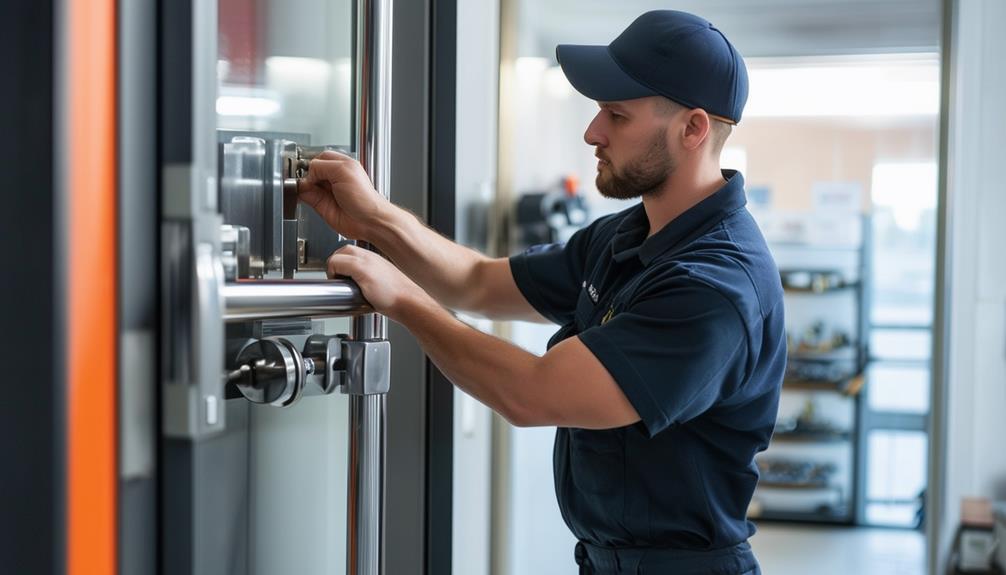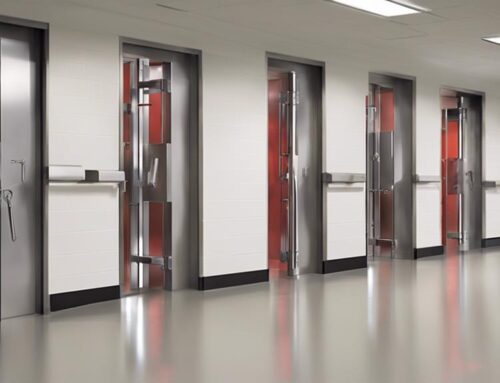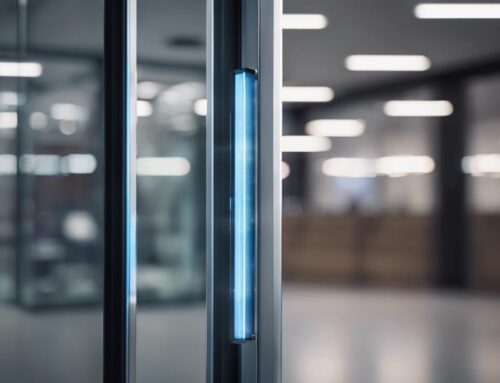To maintain push bars, inspect them monthly for visible damage and ascertain the unlatching force doesn't exceed 15 pounds. Lubricate moving parts every six months with a silicone-based lubricant to prevent dust buildup and reduce friction. Clean push bars regularly with a mild detergent solution, avoiding abrasive cleaners. Document all maintenance activities thoroughly to track performance and ascertain compliance with safety regulations. Check for signs of wear, such as difficulty pressing or visible rust, and replace worn parts promptly. Professional maintenance services can help with complex issues, guaranteeing safety and reliability. Looking into additional details can help you keep everything in top shape.
Key Takeaways
- Regularly inspect push bars monthly for visible damage, obstructions, and proper operation.
- Lubricate all moving parts biannually with silicone-based lubricant to ensure smooth functionality.
- Document all maintenance activities, including inspection dates and tasks performed, for compliance and safety records.
- Replace worn or damaged components like touch pads, latches, and rods to maintain safety and functionality.
- Use professional services for complex issues to ensure compliance with building regulations and safety standards.
Routine Inspection Guidelines

When it comes to guaranteeing your push bars remain functional and safe, conducting routine inspections is a must. Routine maintenance of panic bars is essential to comply with safety regulations and guarantee smooth operation. You should conduct monthly inspections, checking for any visible damage or obstructions around the push bar and door frame. Verify that the unlatching force doesn't exceed the 15-pound limit. Inspect the locking mechanism to verify it engages and disengages without hindrance. Regular inspection of lubrication is vital to maintaining the smooth operation of the locking mechanism. Document all inspection findings meticulously to track the operational history and guarantee compliance. This proactive approach helps in identifying potential issues early, keeping your panic bars in top condition and enhancing overall safety and accessibility standards.
Lubrication Tips

Lubricating your push bars regularly is essential for ensuring they operate smoothly and efficiently, especially in emergencies. Start by lubricating the moving parts of your push bars every six months to reduce friction and maintain their functionality. Use a silicone-based lubricant or light machine oil, which are less likely to attract dust and debris. When selecting a lubricant, consider products that offer resistance to corrosion, as this can further extend the lifespan of your push bars. Apply the lubricant sparingly to avoid excess buildup that could cause mechanical jams in your panic hardware. Make sure the lubricant reaches all pivot points and moving components to prevent uneven wear and premature failure. Regular lubrication is especially vital for emergency exit doors in high-usage areas or corrosive environments, where wear and tear can accelerate, necessitating increased maintenance frequency.
Cleaning and Care

While regular lubrication keeps your push bars functioning smoothly, cleaning and care are just as important to maintain their performance and longevity. Start by regularly cleaning your panic bar with a mild detergent and water solution. Avoid abrasive cleaners or scrubbers to prevent surface damage. Next, conduct an inspection for any signs of corrosion or wear, especially if the environment has high humidity or corrosive materials. Keep the area around the panic bar free from obstructions to guarantee it operates correctly in emergencies. Remember, proper maintenance not only extends the life of the device but also guarantees compliance with fire code requirements. Finally, incorporate scheduled periodic lubrication of moving parts as part of your maintenance routine. This holistic approach to cleaning, inspection, and lubrication will guarantee your push bars remain reliable and efficient.
Replacement Parts

Frequently, maintaining the integrity of your push bars involves replacing worn or damaged parts to guarantee peak performance and safety compliance. Regular maintenance guarantees proper operation and prevents malfunctioning panic exits that compromise safety and security. To safeguard your business effectively, contemplate getting affordable exit device installations from a reliable service provider. Here are four essential replacement parts to contemplate:
- Touch Pads – Critical for smooth operation, replace if they become worn or unresponsive.
- Latches – Guarantee proper latching to avoid malfunctioning panic situations.
- Rods – Check for bends or breaks; replace to maintain structural integrity.
- Mounting Brackets – Secure the push bar firmly; replace if loose or damaged.
Common Wear and Tear Signs

Push bars, like any mechanical device, exhibit several common wear and tear signs that you should watch for to maintain safety and functionality. Difficulty pressing the bar often signals mechanical resistance or misalignment. If the push bar gets stuck or doesn't return to its original position, it might indicate internal jams or worn components. It's important to guarantee that your system adheres to fire code safety regulations to avoid any legal complications. Visible damage, such as scratches, dents, or rust, can compromise functionality and safety. Noisy operations, like grinding or squeaking, suggest worn-out parts or lack of lubrication. Regular inspections are vital, especially focusing on the locking mechanism; any issues with engagement or disengagement need immediate attention. By identifying these signs early, you can guarantee effective maintenance and extend the life of your push bars.
DIY vs Professional Maintenance

Identifying common wear and tear signs on push bars is just the first step in maintaining their functionality. DIY maintenance can help with basic tasks like cleaning and lubricating, but it's important to know when to call in professional maintenance. For instance, regular maintenance using high-quality materials can prevent potential issues from escalating. Additionally, professional services guarantee compliance with current building regulations. Here's why:
- Regular Maintenance: DIY tasks can be performed quarterly to maintain basic functionality.
- Complex Issues: Professional maintenance is necessary for mechanical jams or electrical failures.
- Safety: Improper DIY handling can lead to hazards, so it's critical to guarantee the safety of users.
- Compliance: Professional records carry more weight during inspections and help building owners stay compliant.
Balancing DIY and professional maintenance guarantees push bars operate smoothly and safely.
Warranty Considerations

When considering warranties for push bars, it's crucial to understand what they cover and the responsibilities you have to keep them valid. Typically, warranties cover defects in materials and workmanship, ensuring faulty components are repaired or replaced. Most manufacturers offer warranties from one to five years, with some high-performance models providing extended coverage. To keep the warranty valid, you must perform regular maintenance and adhere to installation guidelines. Neglecting these practices may void the warranty. Some warranties also cover repairs due to wear and tear, but you'll need proof of regular maintenance and inspections. Always review the specific warranty terms and conditions, as they can vary considerably between different models and brands of push bars.
Maintenance Logs and Documentation

Maintaining a detailed log for push bar maintenance is essential for guaranteeing safety and compliance with regulations. Accurate maintenance logs help you track inspection dates, repairs, and any issues encountered. These records are vital for demonstrating compliance and enhancing overall safety. Routine maintenance services, such as those provided by Low Rate Locksmith, can guarantee that your exit devices and panic bars remain in prime condition.
Here's what you should include in your documentation:
- Inspection Dates: Record the exact dates of each inspection to guarantee regular maintenance.
- Tasks Performed: Detail specific tasks, such as lubrication or alignment checks, to maintain transparency.
- Personnel Involved: List the names of individuals who performed the maintenance for accountability.
- Recommendations: Note any suggestions made during inspections for future reference.
Keeping thorough documentation not only improves safety but also protects you from potential liability issues.
Upgrading Push Bars

Upgrading push bars can greatly boost the safety and security of your premises by incorporating advanced features like alarms or access control systems. When upgrading push bars, you'll need to verify that these exit devices comply with local building codes and fire safety regulations. This is essential to avoid legal issues and keep everyone safe. Consider the specific environmental conditions of your location; corrosive environments might require special materials. Upgrading can also involve choosing panic devices that meet ADA standards, improving accessibility for all occupants. Regular assessments of your current push bars can highlight outdated models that need replacement. It's beneficial to explore top brands in the market to guarantee quality upgrades. Proper installation and maintenance are key to making sure these upgrades function effectively and enhance your building's overall safety.
Emergency Repairs

While upgrading push bars can greatly enhance safety and security, emergency repairs are equally important to maintain their functionality. If you encounter issues with your panic bar, acting promptly guarantees safety and compliance. Low Rate Locksmith offers expert installation and repair services that can assist in these situations. Here's what to focus on:
- Misalignment: Check if the door hardware is aligned correctly; misalignment can prevent the panic bar from working properly.
- Mechanical Jams: Identify and fix any jams in the mechanisms to restore functionality.
- Locking Mechanism Failure: Verify the locking system is operational; failure here can pose serious risks.
- Regular Inspections: Conduct regular inspections to catch potential issues early, reducing the need for emergency repairs.
Addressing these points quickly can keep your push bars in top shape, guaranteeing safe egress during emergencies.
Reliable Push Bar Maintenance Services from Low Rate Locksmith

Guaranteeing your push bars are always in top condition doesn't have to be a hassle, thanks to the reliable maintenance services provided by Low Rate Locksmith. Their expert team offers thorough inspections to spot wear and tear, keeping your push bars functional and aligned with safety standards. Regular maintenance, including biannual lubrication of moving parts, guarantees smooth operation and reduces friction. In corrosive environments, more frequent inspections, ideally every three months, are essential to prevent unexpected failures. Low Rate Locksmith also provides detailed documentation of all maintenance activities, guaranteeing compliance with safety regulations. Their technicians specialize in using top-quality products for long-lasting results, guaranteeing your push bars remain reliable. Trust them to keep your push bars in peak performance, enhancing safety and accessibility in your public and commercial spaces.
Frequently Asked Questions
How to Clean a Panic Bar?
To clean a panic bar, use a soft cloth dampened with mild soap solution. Gently wipe down the surface, focusing on the touchpad. Avoid abrasive cleaners. Dry thoroughly with a clean cloth to prevent moisture buildup and corrosion.
Why Is My Panic Bar Not Retracting?
Your panic bar might not retract because of debris causing mechanical jams, misalignment with the door frame, or insufficient lubrication. Check for visible damage, guarantee proper alignment, and lubricate moving parts to resolve the issue.
How Does a Push Bar Work?
Imagine a lifeline in emergencies: that's a push bar. When you apply pressure, it releases a latch mechanism, opening the door effortlessly. It guarantees quick exits without fiddling with handles, vital for safety during panic situations.
Conclusion
So, you think you can just install push bars and call it a day? Oh, how naïve of you! Without routine inspections, lubrication, and proper care, those push bars will betray you at the worst possible moment. Imagine the chaos of a sticky push bar during an emergency! By staying on top of maintenance, you avoid becoming the facility manager everyone loves to hate. Trust us, it's worth the effort to keep those bars in tip-top shape.









